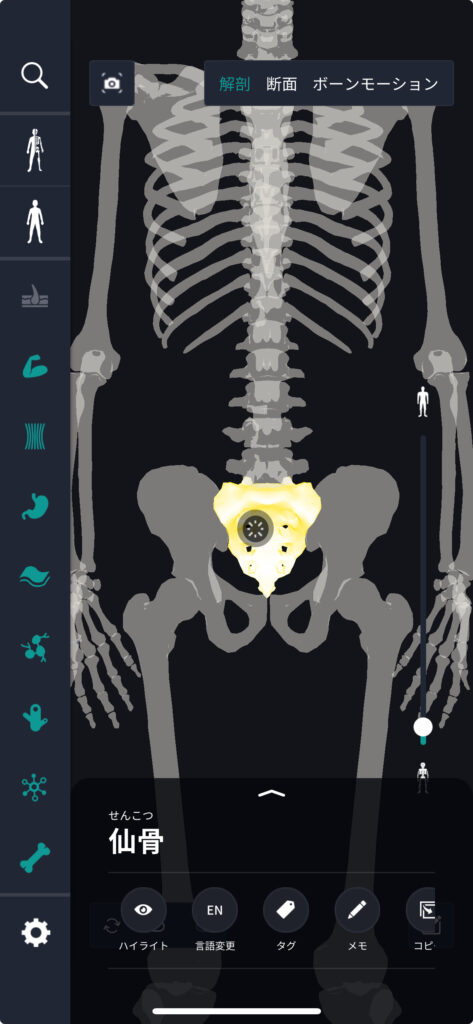beginning
In this article, I will explain the “sacrum” in detail. The sacrum is an important bone located at the end of the spine, and is formed by merging multiple small vertebrae (sacral vertebrae). We will also introduce the characteristics, location, and location of the sacral spine, as well as related trivia. By deepening your understanding of the sacral spine, you can support physical health and proper positioning. Please use this article to deepen your understanding of the body.
Click here to watch a video about the sacrum (sacrum)
teamLab Body Pro Free Download
A 3D anatomy app that shows all the structures of the human body
Download teamLab Body Pro here!

What is the sacrum
The sacrum is part of the spine and is located at the bottom of the spine. In the sacrum, the five sacral vertebrae (S1-S5) fuse as they grow to form one large bone. This bone is located below the lumbar spine and above the coccyx, and forms the left and right iliac bones and joints. The sacrum plays an important role as part of the pelvis, supporting body weight and protecting nerves and blood vessels.
How to read sacrum
Scientifically speaking, it is read as “senkotsu.” As you can see from the kanji for “sacrum,” it indicates an important part of the human body.
Characteristics of the sacrum
The sacrum forms one large bone by joining multiple small bones (sacral vertebrae) in the adult body. The sacral vertebrae are independent when they are first born, but they join as they grow. This process is usually completed by the beginning of the twenties. The curve of the sacrum helps protect the central nervous system and supports major muscle groups.
Location and position of the sacrum

The sacrum is located below the lumbar spine and above the coccyx. Positionally, it is on the back side of the pelvis and is connected to the left and right iliac bones. There is a neural tube in the center of the sacrum, and nerves that pass through here control sensation and movement to the legs. In order to know this part in detail, it is ideal to refer to the human anatomy chart.
How to remember the sacrum
In order to remember the location and name of the sacrum, it is effective to learn along with visuals. You can confirm the actual position using anatomy textbooks or human anatomy maps, and fix it in your memory through repetitive practice.
English and Latin for sacrum
The English name for the sacrum is called “sacrum,” and in Latin it is called “os sacrum.” This name has the meaning of “sacred bone,” and is derived from the fact that it was regarded as important in ancient religious ceremonies.
Trivia about the sacrum
Here are some interesting trivia about the sacrum.
・In ancient Rome, the sacrum was regarded as important as a “sacred bone.”
・The sacrum has five sacral vertebrae fused together to form a very strong structure.
・Nerves passing through the neural tube control sensation and movement from the trunk to the lower limbs.
Tissues associated with the sacrum: characteristics of the sacral spine
The sacral vertebrae (sacral spine) are the five vertebrae that make up the sacrum (sacrum). These vertebrae merge in sequence to form one large bone and are located at the lower end of the spine. The sacral spine functions as an attachment point for bone marrow and muscles, and provides an important passageway for spinal nerves to pass through. The characteristics of the sacral spine are as follows.
The process by which large and small vertebrae fuse together: At birth, the sacral vertebrae are divided one by one, but they gradually merge as they grow. This process is completed by adulthood, and is usually completed by around age 30.
Strong construction: When the sacral vertebrae fuse, they become very strong bones. This efficiently supports upper body loads, and also plays an important role when walking and carrying heavy objects.
Nerve passages: Each sacral vertebra has neural tubes and foramen, and spinal nerves are transmitted to the lower body through this. Because of this, the health of the sacral spine directly affects the functioning of the entire nervous system.
Tissues related to the sacrum: location and position of the sacral spine
The sacral spine is located at the lower end of the spine and is between the lower lumbar spine and coccyx. Here are a few points about specific locations.
Below the lumbar spine: The sacral spine is located below the lumbar spine. It connects below the last lumbar vertebra (L5) of the spine and forms part of the sacrum.
Cooperation with iliac bone: The sacral spine is closely linked to the iliac bones on both the left and right sides. This forms the sacroiliac joint and supports pelvic stability and body balance.
Above the coccyx: The sacral spine is located above the coccyx and is connected to the coccyx. This joint supports body flexibility and motor skills, and is particularly important for sitting and hip movements.
Tissues associated with the sacrum: trivia about the sacral spine
Here are some interesting trivia about the sacral spine.
The sacral spine was known to ancient physicians as “sacred bones.” For this reason, the sacral spine has a spiritual meaning in many cultures.
The sacral spine and sacroiliac joint greatly influence the center of gravity of the human body. It plays an important role in maintaining body balance and is essential for maintaining proper posture.
The sacral foramen, through which nerves pass, can affect the entire nervous system. For this reason, the health of the sacral spine is directly linked to the sensory and motor functions of the lower body, and is an important research subject in the fields of orthopedics and neurology.
The sacral spine plays a particularly important role during childbirth. The sacral spine and sacrum are flexible so that the pelvis expands, and supports the safety of the mother and fetus. This phenomenon is known as “sacral loosening.”
Sacral quiz with correct answers
Q1. What part of the lumbar spine is the sacrum located in?
Correct answer. under
Q2. What is the English name for sacrum?
Correct answer. Sacrum
summary
This time, I explained the location and location of the “sacrum”, how to remember it, and the English and Latin notation.
How was it?
I would be happy if reading this article deepened my understanding of anatomy.
Learning is a long, never-ending journey, but I sincerely wish you all the best. Let's continue to study together and work hard for the national exam!
Please look forward to the next blog.
Learn more with the anatomy app “TeamLabBody Pro”!
teamLabBody Pro is a “3D human anatomy application” that covers the entire body of the human body, including muscles, organs, nerves, bones and joints.
The human body is faithfully reproduced from CT and MRI data based on data from multiple subjects. Since medical book-level content supervised by physicians can be freely viewed from all angles, it can be used for various medical situations, such as explaining surgery to patients and studying anatomy for students.
If you want to see the parts introduced this time in more detail, please download the anatomy application “teamLabBody Pro.”
teamLab Body Pro Free Download
A 3D anatomy app that shows all the structures of the human body
Download teamLab Body Pro here!





